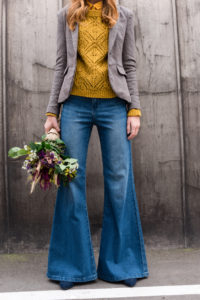By it admin

Denim. The word evokes both casual and dressy. Skinny, cropped, frayed, flared, wide, light, dark, embellished, acid washed, classic, Elvis, Hollywood, cowboys, Rihanna, boyfriend, James Dean. The list goes on. We all have stories of our favorite pair growing up, our favorite pair as an adult, the mistake jeans, the cut offs we experimented with, and the fashion trend (flared) we are holding onto as we know they will come back. Obviously.
With COVID-19 and current work-from-home culture, it may be tough to think of wearing jeans again as we are all sporting “athleisure” wear these days, but denim style will always be iconic, evergreen, American but also international, genderless. Denim has endured for decades before and will continue well past the pandemic.
Jacob Davis and Levi Strauss developed the original Levi 501 jean in 1873 as a purely utilitarian work outfit known for durability, but not style. Denim first became popular in the 1920s and 1930s in tandem with the rise of Hollywood as the uniform of the lone cowboy and synonymous with the romance and promise of the American West. Over the years, the cuts and washes changed but denim’s position, as a relatively democratic element of the wardrobes for both stylish and casual people did not.
If you want to learn a bit more about denim and hit your favorite second-hand store to update your wardrobe with both vintage and modern finds, here is a walk down memory lane for decades of denim:
1960s-1970s: Bell-bottoms, fit and flare, boot cut, frayed

Farah Fawcett with bell-bottoms became THE signature style of the decade and denim became more mainstream and not simply associated with cowboys and westerns. Celebrities like Cher, Mick Jagger, and Jimi Hendrix all made the fit and flare look popular.
By the 70s, frayed and patched-up jeans became popular. They were also more fitted at the waist and moving away from the boxy look. Bell-bottoms as a fashion statement first appeared in 1972. Love it or hate it, you will remember it!
1980s: Acid wash and tapered legs

Daisy Duke with her super short cut-off jean shorts and the denim jacket made famous by Madonna. The colors were darker and more punk and rock inspired.
Rips, faded jeans, grunge looks were all par for the course. There are no rules with denim after all.
1990s: Looser, higher-rise mom and dad jeans

Remember Jerry Seinfeld’s uniform dad jeans and sneakers for a decade on television? And embellished jeans on Saved by the Bell that started a rage of people going crafty with their jeans and people still talk about Cindy Crawford’s iconic high-waisted jeans for a Pepsi ad during the Super Bowl. Moreover, Princess Di became the first member of the royal family to be photographed in denim.
You know what they say if it is good enough for royalty.
2000s: All over the place with low rise, skinny, and lace-ups
The early 2000s mimicked the 70s with the low-rise flared jeans making a comeback. The bell-bottoms almost came back. Almost. Even capris made a brief peek-a-boo comeback. And jeggings made an appearance.
However, the rise of leggings and yoga pants eclipsed durable jeans as the go-to apparel choice for a while. But not for long.
2010: When jeans stopped being blue
For a stint, jeans stopped being blue at all and colored jeans took over. Overalls returned for a brief stint—only fitted this time. And flared jeans came back, but cropped. Frayed hems from the 70s made an appearance too.
In short (or cropped or hemmed), jeans are a staple in any wardrobe that has endured for decades. And like other important milestones in life—the perfect job, the perfect partner, and the perfect house—the perfect pair of jeans takes time and a mix of trial and error. So when you find that perfect fit and style—especially at a second-hand store for an affordable price and the fit you’ve always loved and been looking for—you always buy it. Always. As good denim never goes out of style.
Final jeans fact for you as a denim purveyor: Ever wondered who first paired a pair of skinny jeans with a white t-shirt for the classic look? Brigitte Bardot in 1957.


